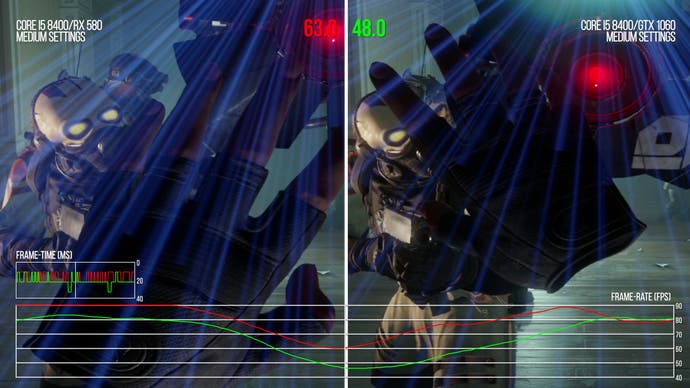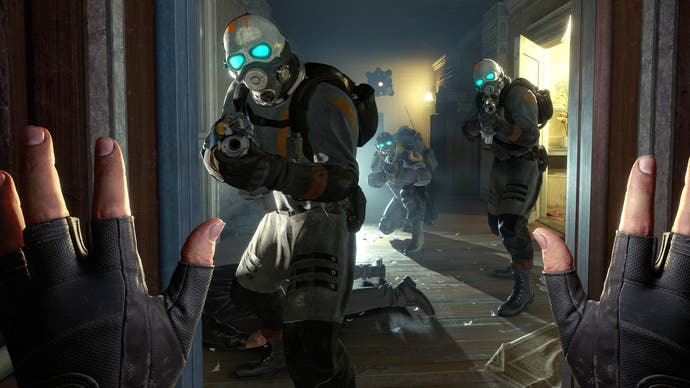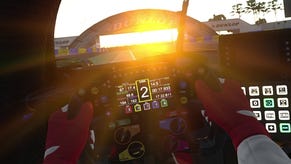Half-Life: Al tech analysis - a VR masterpiece that must be experienced
Plus: What kind of performance does minimum spec hardware actually deliver?
It's not often that a new title arrives that genuinely moves gaming forward - but that's exactly what Half-Life: Al delivers, showcasing virtual reality in ways that have never been attempted before, backed up by top-class design and brilliant production values. Some might say it's the first true triple-A experience for the VR medium but that should come as no surprise: as a franchise, Half-Life has always focused on breaking barriers. From the original game and its cinematic, continuous world to Half-Life 2 and its focus on physical interaction, this is a series that is synonymous with innovation and that takes on a new dimension - literally - in this new adventure.
It's been a while since we last visited City 17 and much has changed from a technological standpoint. This time, the journey is framed by Valve's Source 2 Engine. While the core technology been around for some time, this is the most ambitious game yet developed on this platform. The challenges tackled by this engine are certainly significant - faster refresh rates are required by default to power headsets that usually run at 90Hz, but Valve also wanted to deliver one of the most detailed VR experiences yet.
What this means is a game world built around gorgeous, realistic physically-based materials with a lot of care poured into every corner of the world. In VR, even the most minor detail can be studied up close, meaning that all aspects of the presentation require an exceptional level of detail. The art team has done a remarkable job here - the size and scale of the world is almost perfect and the wow moments in transitioning from a tightly enclosed environment into a bigger, wider world fully deliver.
Al's visuals are clearly impressive, but what really sells the experience is the sheer level of interaction across the board. In fact, the game is defined by its interactivity - and the sheer granularity of the actions required to play is what makes it unique. For example, the simple act of firing your weapon is taken to a whole new level in VR. It's not just about more realistic aiming - your actual physical movement plays a key role in how combat plays out and I found myself ducking behind objects and leaning out from cover. It's a level of physicality that dramatically enhances combat and then... your gun runs out of bullets.
In a traditional shooter, reloading your weapon requires a single button press - a tap of the R button on your keyboard is all it takes to execute a reload. Simple. With Half-Life: Al, however, this process is now driven by a series of steps - you start by ejecting the magazine from your pistol. Then you reach over your shoulder to grab a fresh mag and jam it in, then you chamber a round and finally, you're back in the game. Eventually, you'll gain the ability to hold more rounds in your pistol and the game keeps track of bullets in each magazine. You'll need two of them to fully load the enhanced pistol - and I really appreciated how pulling out a partially used mag reveals a proper bullet count.
This is just the tip of the iceberg in terms of how objects have true physicality in the game world, and there's a huge emphasis on physics simulation generally. Each environment is packed with individual objects, all beholden to in-game physics emulation - a nice evolution of the technology we first saw way back in Half-Life 2. One of the key changes here is the ability to pick-up and manipulate all these objects: you could pick-up objects in Half-Life 2, but realistically, handling them amounted to the object floating in front of the player or the gravity gun. In Half-Life: Al, you physically (virtually?) pick up objects with your hands and examine them at your leisure.
These properties have an influence on world objects which can jostle and move about during gameplay, all of which is transformative. The mundane becomes extraordinary. The simple act of rooting around drawers, crates and buckets is fascinating in itself as every object has its own realistic physical attributes. Instead of simply clicking a single button to search, you're physically reaching in to sort through the objects. Objects can be placed within other objects, and so forth.
Physics also factor heavily into gameplay - in one scene, while facing a blind enemy that tracks its prey via acute hearing, the name of the game is to avoid making noise. At one point, a headcrab crawls above you, knocking down some glass bottles. If you're fast enough, you can catch them in mid-air to avoid them shattering and drawing attention to your location. Again, it's a simple idea on paper but the idea of interacting with individual objects with this level of granularity is so important to the experience - and it's beyond anything possible in a controller-driven game.

Of course, you also have the Russells - a pair of anti-gravity gloves that allow the player to pull objects towards them with a simple flick of the wrist. It's a brilliant mechanic for interacting with distant objects that's a lot of fun to use. Once those objects are in front of you or in your hands, it becomes easier to appreciate the level of detail on display. For example, the various CRT monitors in the game have real inputs including dual RGB SCART connectors. Or, in Russell's lab, you can closely examine the various monitors, including one that seems to show the source code that drives the Russells.
Before this, there are the marker pens - similar to Valve's own The Lab, you can draw on surfaces such as glass or whiteboards. It's a fun gimmick and the quality of the interaction is so natural that you can even sketch out quick drawings. There's even a working piano here in the game - one that probably works best with Valve's own Index headset and controllers, I'd imagine, but it's still fine with Oculus Touch.
The point is, there are a lot of fine details spread out across the world and the physical nature of everything makes for a more believable and engaging experience all around - but it's the concept of physics that sees some fascinating similarities and differences with VR's other showcase game: Boneworks, built by Stress Level Zero on the Unity engine. Al features a lot of objects with physical properties attached but most of them aren't central to the core gameplay mechanics. They're simply part of the world, enabling a more realistic environment to play within. Boneworks, on the other hand, uses physics as a central gameplay mechanic and it has an arguably more profound impact. What does this mean for the player?
Al's combat is essentially weapons-based while Boneworks goes in a different direction - everything has physics, including weapons, and anything can become a weapon or tool. You can run up to any enemy in the game and interact with them directly. You can push them, grab them or use any random object to deal with them. You do have firearms but those weapons are not locked to your hand. You physically pick them up and keep the grip button pressed to hold them in your hand. You have more options at any point, lending the game a sense of freedom quite unlike anything else. It's all about using what's around you to survive - and it works.

Half-Life: Al has echoes of this in some situations. Headcrabs, for instance, can be dealt with in this manner using objects scattered around the environment. You can deflect them and it's a lot of fun, but this isn't really true of any other enemies. Trying to throw objects at them or whacking them or even just pushing them is fruitless - you won't do any damage and you won't influence their behaviour in any way. Boneworks essentially allows for melee combat using any object you can get your hands on - something that would work really well in Half-Life too.
The differences don't stop there, however. Boneworks' traversal and puzzle-solving mechanics are heavily reliant on physics while Half-Life tends to rely more on carefully crafted sequences that feel more polished. This is the single most fundamental difference - Half-Life presents tightly designed, highly tested puzzles that are fun to solve and play out beautifully. Boneworks attempts something arguably more ambitious by presenting problems with multiple solutions, completely driven by the physics simulation and in-game systems. It makes for a surprisingly free-form experience but it also means lots of glitches and other weirdness can occur, which is rarely an issue with Half-Life: Al.
And perhaps Boneworks sticks too closely to this model by giving the player an in-game body that is also impacted by the physics systems. This means that objects can cause the entire camera to shift based on collision - something that breaks a lot of the rules learned in VR development and that can cause a lot of discomfort for many players. Thankfully, motion sickness isn't an issue for me during play but I've witnessed other players really struggling with Boneworks as a result and there is the sense that the game could perhaps be a little kinder and more flexible in order to appeal to more players.
There are other small details too that I really appreciate in Boneworks - you can pickup a flashlight, for instance, and that light projects shadows from everything including your body which helps root you into the world. It also means you can make hand puppets on the wall, which is great fun. In Al, this is not the case - the flashlight does not project shadows from your hands, just the world.

So, if we step back and look at the big picture, I feel that while Half-Life: Al is a mainstream-friendly showcase for virtual reality, there are actually two essential, groundbreaking VR experiences out there - and both push boundaries in their own ways. Al feels like a more polished game with a lot of very creative, carefully designed set pieces that still benefit greatly from enhanced VR interaction. However, I also think that Boneworks is unmissable. There are crossovers and commonalities with Half-Life: Al and while it lacks polish and accessibility, its gameplay foundations are built more closely around physics, with some spectacular moments. Ultimately, I love them both and feel that they both help to push the VR medium forward.
With that said, Al also benefits because it's very definitely a full-blooded Half-Life game. While it may be presented via a very different gaming medium, the classic Half-Life DNA is fully represented here, constantly reminding me of the things I love most about the franchise. Each chapter delivers a unique concept and there's a constant sense of surprise throughout. Valve typically reserves new Half-Life games for moments when new innovations could help drive gameplay to new heights and I feel that the studio has completely succeeded here. Valve's efforts are so finely tuned and polished that it's difficult to walk away unimpressed. Quite simply, this is a masterpiece and one of the most engaging experiences you can have with a video game right now.
If you're interested in checking it out, you'll find that there are a wide range of headsets available that should deliver a good experience. I played on Oculus Rift S and found it to be a comfortable, clean experience but I'd imagine the Index is a further a step up owing to individual finger tracking (three fingers are grouped together on one button with Oculus Touch). The classic Vive is one which is perhaps less well suited if you want to utilise continuous movement, as the touch discs on the Vive wands aren't optimal for free movement. The point is though that the game supports a wide range of HMDs. We can't test them all, but there's enough user feedback out there to get a pretty good idea of how each of them stacks up, and we have our own guide to the best VR headsets for Half-Life: Al too, of course.

In terms of PC specs, a Core i5 7600 paired with either an Nvidia GeForce GTX 1060 or AMD Radeon RX 580 is Valve's minimum spec requirement. We tested both of these GPUs with a more powerful Core i5 8400 and can confirm a largely decent experience on both cards at medium settings with the higher quality hologram options disabled. Gameplay runs at 70-90fps for the most part, but the asynchronous timewarp frame blending technology does a reasonable job of hiding dropped frames. What we did find is that the RX 580 is significantly faster overall, but exhibits more frame-time inconsistency than the GTX 1060, meaning that the async timewarp blending is not as effective in some scenarios. Also curious is that we seemed to be CPU-bound in many cutscenes where frame-rate could drop significantly regardless of which of the graphics cards we were using.
In tuning the game, we didn't see a huge amount of visual difference between low and ultra settings, principally because nearly all lighting and most of the shadows are pre-calculated and 'baked' into the game, while geometry level of detail cannot be altered. We'll have a more detailed look at the settings in due course but fundamentally, the most dramatic improvement to performance comes from the volumetric lighting setting, where dropping from ultra to low gives you an extra 20 per cent of performance. Ultimately, the minimum spec for Half-Life: Al can still deliver a decent gameplay experience - but we'd likely recommend GTX 1070 rather than GTX 1060 as the more ideal entry point from the Nvidia GPU perspective. From a CPU perspective, if the Core i5 8400 isn't totally consistent, the i5 7400 will have even more issues in running the cutscenes, so that's worth factoring in too.
The cost of entry is clearly significant for a full-blooded, silky-smooth Half Life: Al experience. Not only will you need a VR headset (a used Oculus Rift CV1 with Touch controllers is probably the cheapest entry point) but a cut above the average mainstream gaming PC is required to maintain a crisp, consistent frame-rate across all parts of the game. Is this extravagant level of expense worth it for a single title? Probably not, but perhaps that misses the point. Valve has delivered a halo product for the entire medium - and once you have the hardware, there's a wealth of brilliant VR experiences out there to enjoy. As a catalyst for VR adoption, the medium needed a game as significant as Half-Life: Al and if you do take the leap, I don't think you'll be disappointed. But just as important is that you'll have everything you need to continue your VR journey.










